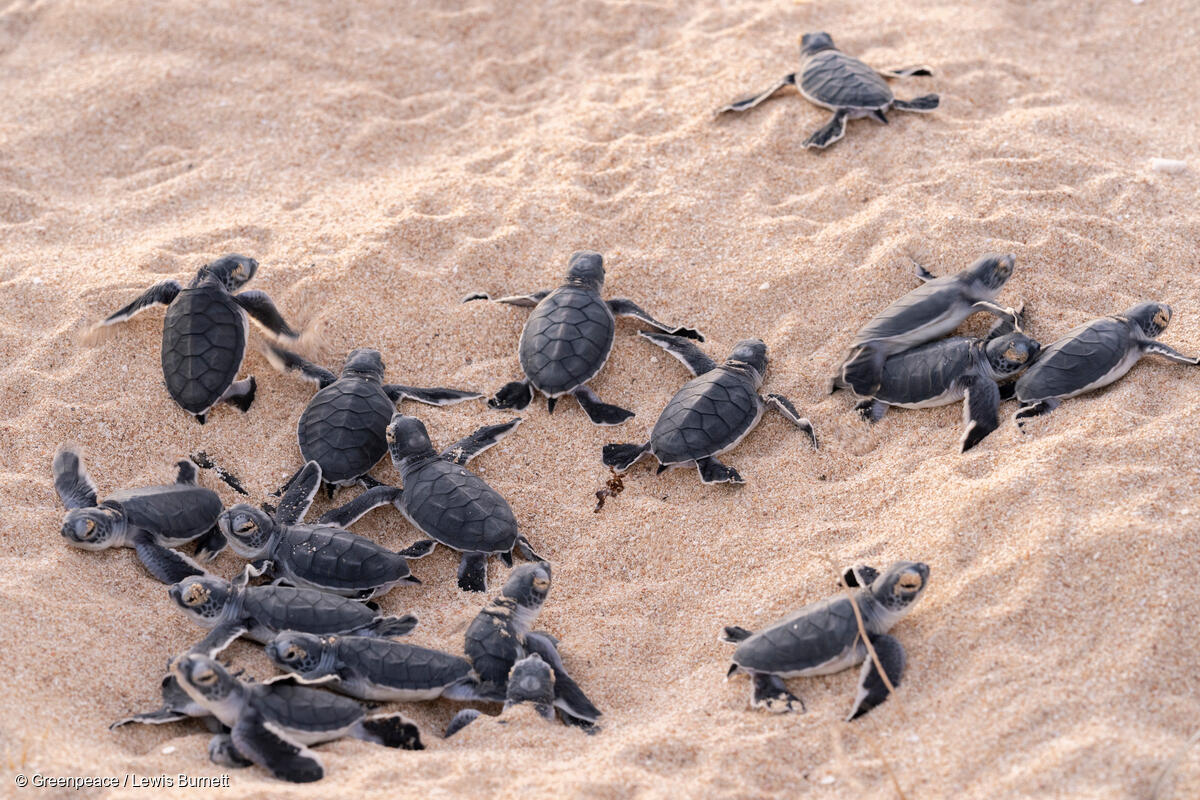Welcome to megafauna highway and the longest-fringing coral reef in the world, Ningaloo Reef. Home to some of the most interesting wildlife in our oceans, this World Animal Day, let’s take a dive in and take a closer look at some of fascinating species that calls this place home:

Stretching over 260 kilometres along the west coast of Australia, UNESCO heritage-listed Nyinggulu or Ningaloo Reef (which translates to “deep water” by the Traditional Owners of the land) is the longest-fringing coral reef in the world.
Considered one of the planet’s largest biologically diverse marine ecosystems and a highway for megafauna, Ningaloo is home to some of the most interesting wildlife in our oceans. So to help us celebrate this World Animal Day, here are 5 fascinating facts you may not know about the wildlife that calls the world’s largest-fringing coral reef home:
Say hello to 6 out of the world’s 7 marine turtles:

A number of Green Turtle hatchlings begin to erupt from a nest site as the sun sets and the temperature drops on a beach near Ningaloo Reef in Western Australia.
Did you know that more than 3,000 species of marine life, including 200 coral, 500 reef fish, 600 crustaceans, and 1,000 marine algae call Ningaloo Reef home sweet home? Not to mention 6 out of the world’s 7 species of marine turtles, 3 of which (the endangered green, loggerhead and critically endangered hawksbill turtle) call the reef their home year-round. This leads to the wonderful phenomenon of approximately 10,000 turtle nests dug each year along the Ningaloo Coast! Egg-cellent.
And the highest density of humpback whales in the Southern Hemisphere:

Aerial shot of humpback whales migrating along the Ningaloo Coastline in Western Australia, taken from a helicopter.
It’s not just the east coast of Australia that sees thousands of humpback whales migrating to our warmer waters each year. The west coast, in particular the Ningaloo Coast actually has the highest density of humpback whales in the Southern Hemisphere during their annual 11,000km migration from Antarctica! Scientists estimate that 30,000 humpback whales visit the Ningaloo Coast each year on their way to their breeding and birthing grounds further north off the Kimberley. It’s one reason why the area is known as a megafauna superhighway!
Welcome to the home of the whale shark (and plenty of other sharks and rays!):

Whale shark seen during Greenpeace Rainbow Warrior documentation trip off Exmouth, Western Australia.
Ningaloo Reef is fondly known as home of the whale shark, aka the world’s largest known fish, because it is one of the only places in the world where the gentle giants regularly aggregate in large numbers. These docile and distinctively spotted creatures are filter feeders, meaning as the name implies, a whale shark’s diet is rich in plankton and krill.
Meanwhile, we know that there are two types of manta ray in the world (oceanic and reef mantas), but did you also know that Ningaloo Reef is considered to be one of the few places in the world where you can be lucky enough to spot both?! Congregating at Ningaloo Reef year-round, manta rays, like their cousin the whale shark, are also filter feeders and feast on the large amounts of zooplankton found in the area.
And more than 10% of the world’s dugong population:

Aerial shots of dugongs and dolphins swimming at Ningaloo Reef.
Once thought to be mermaids by early sailors, dugongs (aka “sea cows”) are another species of gentle giants that can be found year-round at Ningaloo Reef. In fact, thanks to the area’s vast seagrass meadows, and a dugong’s hungry herbivorous appetite, Ningaloo Reef is believed to be home to more than 10% of the world’s dugong population. Sadly, like coral reefs, seagrass populations are threatened by the ongoing effects of the climate crisis, through sea level rise, salinity levels and ocean, and is one of the many reasons global dugong populations remain a vulnerable species.
Plus a coral reef that can be seen from space:

View of the reef documented during Greenpeace Rainbow Warrior’s trip off Exmouth, Western Australia.
Did we mention that Ningaloo Reef is the world’s largest fringing reef? Or that it can be seen from space and is home to over 250 species of coral?! Stretching over 260 kilometres (that’s 226 times the length of the Sydney Harbour Bridge), Ningaloo Reef is believed to represent 50% of coral species in the Indian Ocean. What also makes Ningaloo so special is that coral reefs often don’t grow so close to a landmass, because rain washes silt into the water, making it cloudy and hindering coral growth. However, the arid climate of the Ningaloo Coast helps keep the water mostly clear. This means you can reach the reef simply by swimming from the beach.
…We told you Ningaloo Reef was fascinating!
Ningaloo Reef is an extraordinary place, as is the precious wildlife that calls this place home. Its unique and delicate ecosystem is one that we need to ensure is protected from the devastating impacts of the climate crisis. This World Animal Day, and every day, it is crucial to protect the reef and its biodiversity to ensure the survival of these incredible creatures.
